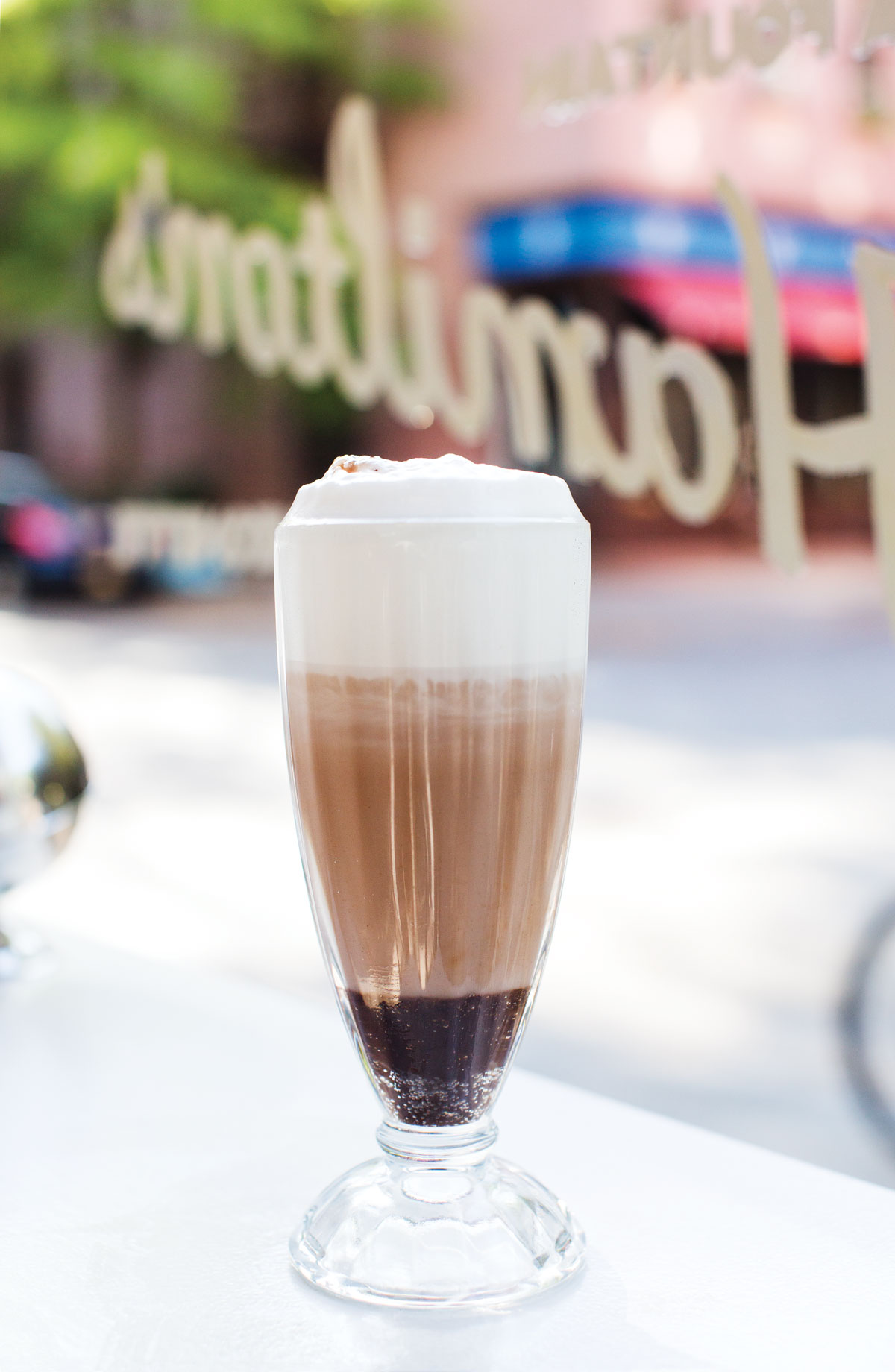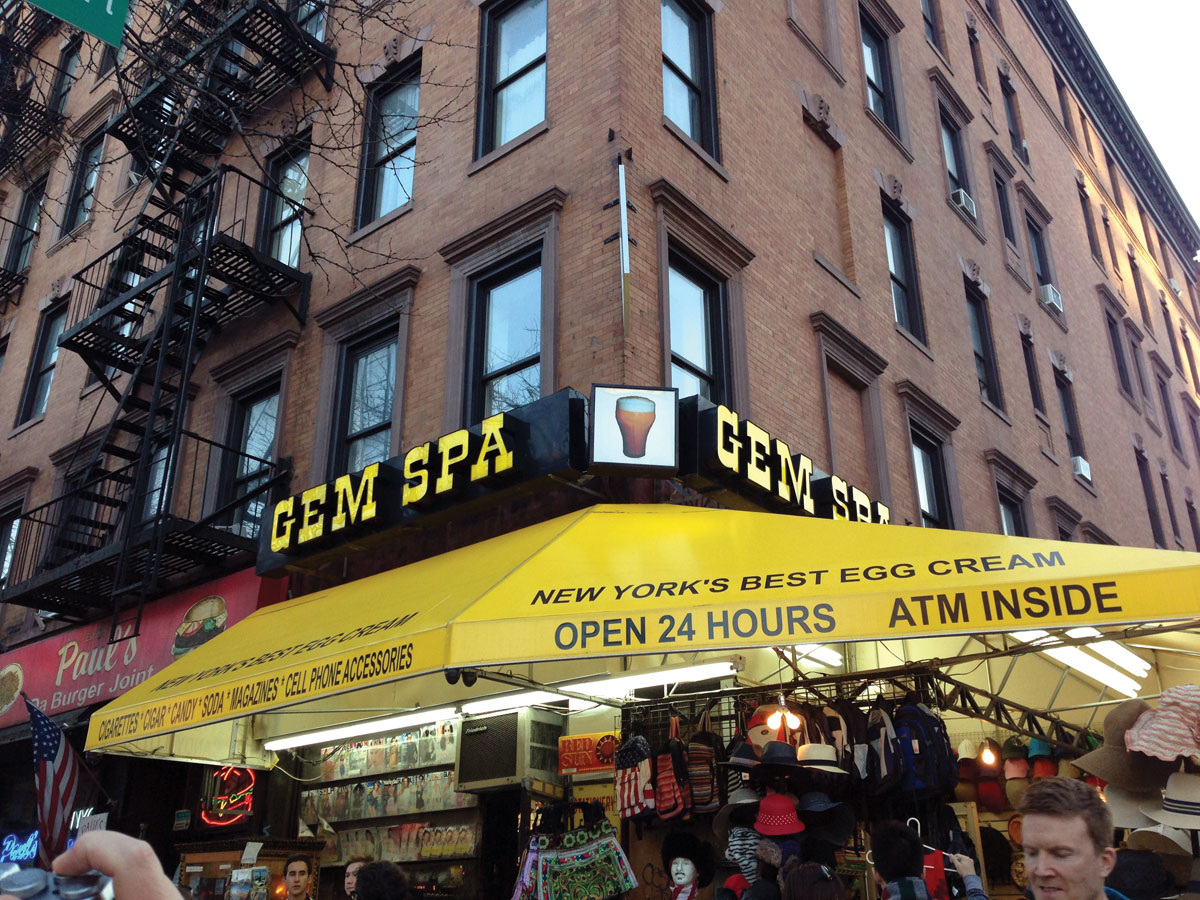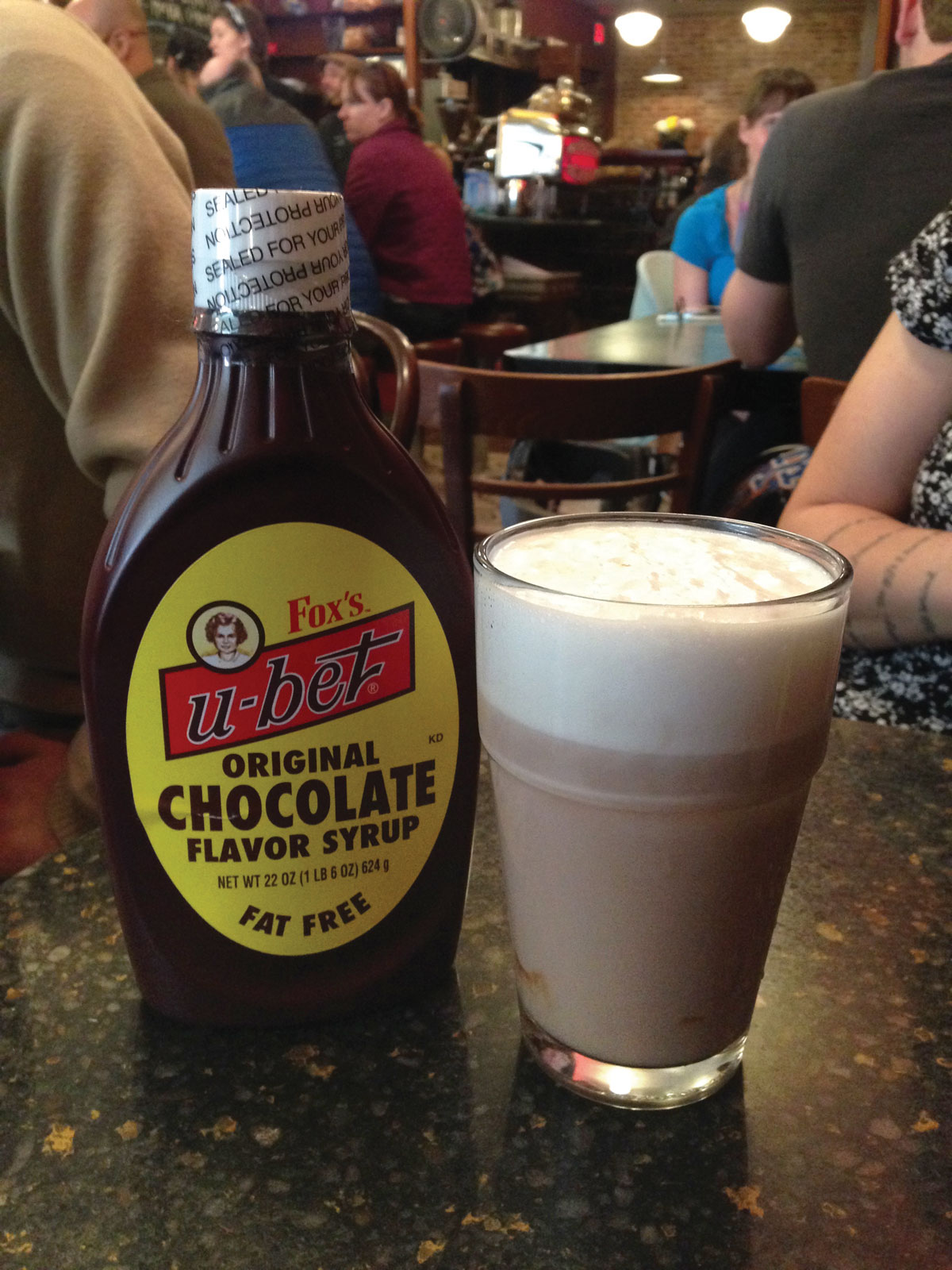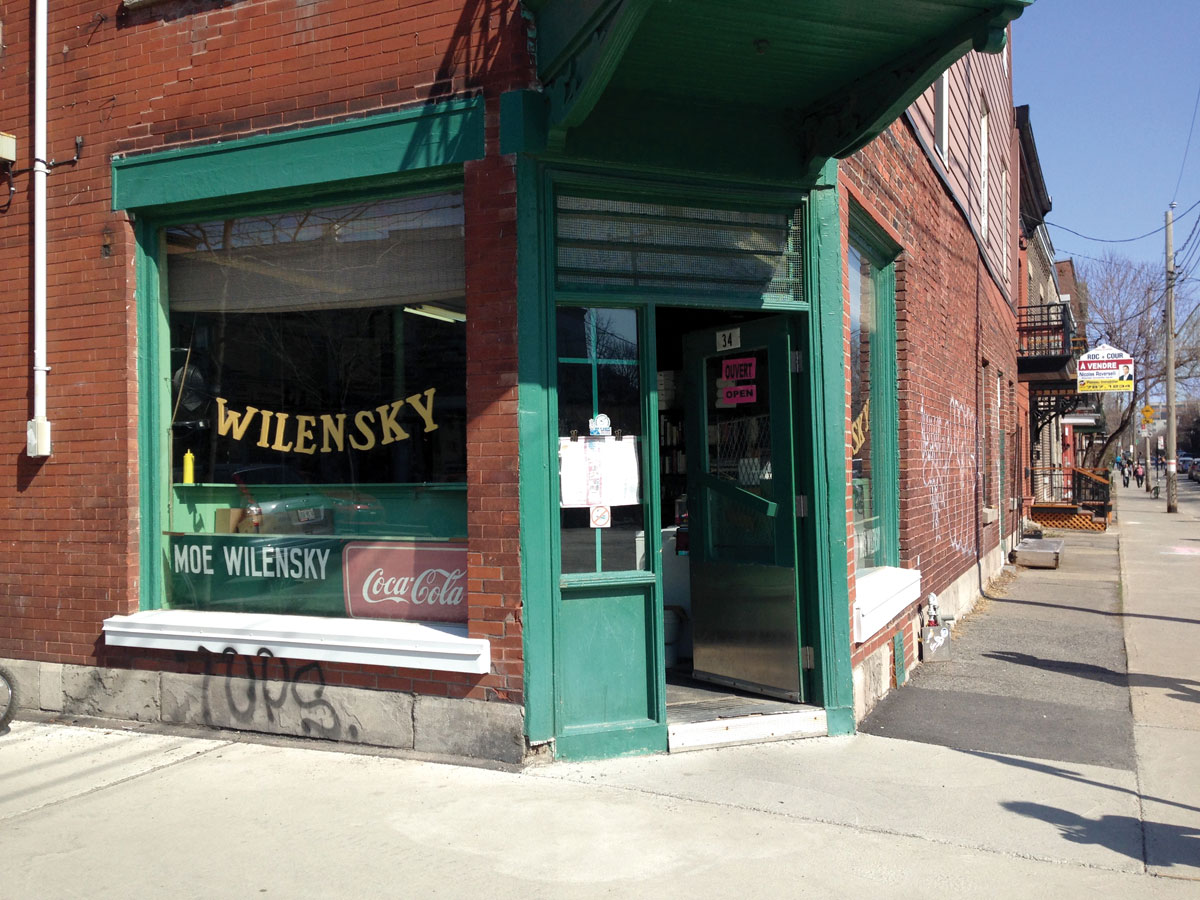
Wilensky’s Light Lunch is located in Montreal’s Mile End neighbourhood, on the corner of Clark and Fairmount. It has changed very little since moving from its previous home, just down the street, in 1952. It is owned and operated by the Wilensky family, as it has been for all of its eighty-three years as a luncheonette, and the twenty-five years in its previous incarnation, as a combination cigar store and barbershop. Its laminated counter seats nine, down from ten—a stool was removed years ago to better serve takeout customers. There are no tables, despite a small-dance-floor-sized space occupying most of the restaurant’s visible square footage, handy for corralling the lunchtime crowds. The windows of the cabinets lining the lime green wood-panelled walls behind and beside the counter are covered with mementos and clippings from newspapers and magazines, some of which use Wilensky’s as regular fodder. A display fridge sells strings of karnatzel and take-home portions of salami. There are candy bars for sale behind the lunch counter, and a case of used books lines the opposite wall. Aside from a few modern heating and electrical additions haphazardly tacked onto the panelling over the years, a Wilensky’s regular transported here from 1952 probably would not immediately register any passage of time. Even the menu appears to have undergone minimal change: a Kraft cheese or chopped egg sandwich sells for four dollars and nine cents; a milkshake for two forty. Coffee and soda water are a dollar fifteen and fifty-seven cents, respectively. And for a dollar seventy, a customer can cool off on a hot summer day with an egg cream—or “soda frappé,” as the French side of the menu describes it.
Most Canadians have never heard of an egg cream. Neither have most Americans, for that matter. It is a relic from the glory days of the soda fountain, when every drugstore and candy shop employed a “soda jerk”—young men who “jerked” the fountain taps to mix seltzer water with a variety of flavoured syrups to produce cherry Cokes, lime Rickeys, and chocolate sodas. Although the egg cream was available at soda fountains across North America in its peak years, it remains firmly—almost exclusively—associated with “old New York,” taking its place in memory alongside spaldeens, the Third Avenue El, and Ethel Merman. The Brooklyn-born comedian Mel Brooks said of drinking an egg cream, “Psychologically, it is the opposite of circumcision.” Today, egg creams can be found in a handful of U.S. cities, but for the most part, the drink is little remembered outside the five boroughs.
As the Canadian city most akin to old New York, it’s not surprising Montreal is home to a diner that may, unintentionally, be holding the torch as the purveyor of the country’s last authentic egg cream.
The egg cream, famously, contains neither egg nor cream, though there is much disagreement about whether this was always the case. Recipes for drinks called “egg creams” appeared in cookbooks at least as far back as the mid–nineteenth century. These early recipes did contain eggs and cream (or milk), along with cinnamon oil, vanilla, and a number of other ingredients. They were considered nourishing and especially suitable for those with weak digestions. One version was recommended as a salad dressing.
Many believe the drink dates back to the first soda fountains, which began to appear in the early eighteen-hundreds, as chemists-cum-businessmen found ways to artificially carbonate water. American settlers had been convinced of the healing properties of the mineral water that flowed from the sacred springs of the Native Americans, and even as the understanding and practice of medicine advanced during the Industrial Revolution, mineral water continued to be thought of as a magical cure-all. Along with aiding digestion, it gave its imbiber energy when he felt sluggish, and calmed him down when he felt nervous: Pepto-Bismol, Red Bull, and herbal tea in a single glass.
The soda fountain entered its golden age near the end of the century, when the cost of artificially carbonating water dropped, and pharmacists saw a potential for profit. In the days before pills became commonplace, medical remedies were offered mainly in liquid form. Soda water made less-palatable ingredients go down easier, and became a common mixer. Until the early twentieth century, pharmacists in the United States had free rein to prescribe nearly any drug they saw fit. Many of the resulting liquid tonics did little or nothing to cure ailments. Others contained addictive substances, such as cocaine, heroin, or morphine. They also contained as much alcohol as a stiff drink, and at a fraction of the price. Not surprisingly, by 1875 taverns found themselves in competition with soda fountains—there was at least one in almost every city in the United States, serving twelve hundred drinks per day. By the time Congress passed the Pure Food and Drug Act, in 1906, banning the casual use of many addictive chemicals, the soda fountain was entrenched as a major societal hub, no longer found only in pharmacies, but everywhere from candy shops to department stores. By 1911, there were a hundred and twenty-five thousand fountains in the U.S. alone, making five hundred million dollars annually on soda-based drinks that usually cost no more than a dime a glass.
To keep up with the competition—and the times—pharmacists invented new ways to entice their clientele. They installed bigger and more opulent fountains, decorated with mirrors, marble, brass, and Tiffany lamps, and surrounded them with bars, table seating, and player pianos. As fountains became fancier, so did the drinks they served. A single fountain could offer dozens of different concoctions. Soda jerks began mixing seltzer water with fruit, ice cream, and anything else that would give their shop an advantage over the one on the next corner. Drinks containing eggs were a staple of soda fountain culture, and a common ingredient in early milkshakes, used both for their health benefits, and to create a frothy texture. Whether any of these drinks are ancestors to the non-medicinal egg cream that would become a New York staple is unknown, but a connection seems likely.
The egg cream New Yorkers talk about when they talk about egg creams today usually is said to have been invented around 1890, by Louis Auster, a Jewish immigrant who ran a candy shop at the corner of Second Avenue and Seventh Street, on New York’s Lower East Side. The candy shop was the centre of every New York neighbourhood, usually housing a newsstand, rows of sweets, boxes of cigars, and a soda counter. Unlike earlier drinks that shared the name, Auster’s egg cream contained only milk, seltzer water, and an in-house chocolate syrup that Auster mixed in secret. The egg cream was popular immediately, selling three thousand glasses per day. Lineups for an Auster egg cream were so long that standing to drink one became tradition.
Sometime between the wars, a national dairy chain offered Auster a small sum for exclusive rights to his egg cream and syrup recipe. When Auster refused, one of the organization’s executives threw an anti-Semitic remark in his direction. Auster was enraged. He promised to take the secret of his egg cream syrup to the grave, and made his heirs vow the same. The last of Auster’s chain of stores closed in nineteen-seventies, and with it went his legendary egg cream.
Not everyone believes the Auster legend. In a 1971 New York magazine article, Daniel Bell, a Harvard professor and one-time journalist, claimed the egg cream was invented in the nineteen-twenties, by his uncle Hymie. Like Auster, Hymie ran a candy store on Second Avenue, one block north, near Eighth Street. He also made his own syrup, which he used in chocolate sodas (one part syrup, two parts seltzer). According to Bell, Hymie created the egg cream while looking for a way to mix melted chocolate ice cream into his chocolate soda without the cream settling at the bottom. Hymie turned to the egg malted—a sweet-tasting, kid-friendly delivery system for the raw eggs Jewish mothers felt would keep their children healthy. Eggs thickened the malted, and Hymie figured they would do the same for his chocolate cream soda, which he renamed the “egg cream.” Hymie’s egg cream was extremely popular with customers, and widely imitated by neighbourhood competitors. When the Depression arrived, Hymie discovered his rivals were lowering prices and cutting costs on their versions of his egg cream by removing the eggs, replacing the cream with milk, and using a more pressurized seltzer stream to create a deceptively cream-like foam head. Hymie refused to taint his creation, and took down his egg cream sign for good.
Hymie’s story is told almost as often as Auster’s, but hasn’t tarnished the latter’s reputation as the egg cream’s originator. Usually, if you’re going to claim to have invented the telephone, you say you did it before Alexander Graham Bell, not after.
Those who choose to believe the egg cream takes its name from its ingredients are missing out on one of the great phonetic-based beverage debates of the twentieth century. Nearly all of the popular theories on how the egg cream got its name stem from linguistic misunderstanding. One, which, if the Auster story is true, seems the most believable, puts forth that Jewish customers would refer to the drink with a Yiddish phrase sounding like “echt keem,” said to mean roughly “pure sweetness,” which non-Yiddish speakers then Anglicized as “egg cream.” Less believable: soda shop visitors were in fact asking for an “A” cream, after the Grade A milk used as the drink’s base. The most charming, and oft-repeated, theory involves Boris Thomashefsky, the Ukrainian-born singer and actor responsible for bringing the first Yiddish play to New York, in 1882. Thomashefsky, the story goes, once asked a local soda jerk to reproduce a drink he had enjoyed in Paris—known as a chocolat et crème.
With no hard evidence supporting any one theory of the egg cream’s invention, even the drink’s purists are flexible in their beliefs. This is significant, because they are flexible about little else. A “proper” egg cream must be made with cold, nearly frozen whole milk—it tastes better, and even two per cent won’t foam up thick enough. Likewise, commercially canned or bottled fizzy water also won’t do. Only seltzer streamed from a pressurized tap can create the right amount of froth to show you’re drinking an egg cream, not merely a glass of chocolate milk. And, if there was a legislative body with the power to name an official egg cream syrup, the title would go to U-Bet, manufactured in Brooklyn, for more than a century, by H. Fox & Company, and used in egg creams since 1904. (The U-Bet bottle even lists an egg cream recipe on its label.) How U-Bet eventually became the egg cream syrup of choice is another bit of unsteady lore, but those who insist on it say its superiority stems from its less sweet chocolatey taste, and its flavour-enhancing use of powdered milk. You can use vanilla, caramel, or other flavoured syrups—but if you do, you can’t call the result an egg cream.
Some gin aficionados insist shaking a Martini “bruises” the spirit and alters its taste. Others will admit to preferring their Martini stirred because of the resulting clean, unclouded presentation it produces. Egg cream lovers take the preparation of their drink just as seriously. Not even the most authoritative sources agree exactly on how to make an egg cream, but for pure artistry, there is only one method.
The two tools needed to make an egg cream are a twelve-ounce glass (ideally a bell glass, sometimes called a Coke glass), and a long spoon. Insert the spoon into the glass and pour in three ounces of milk. Add seltzer, with the tap set for a thin high-pressurized stream, until the resulting foam reaches the glass’s rim. (Holding the glass at an angle and bouncing the water off the bowl of the spoon agitates the drink more and results in a better head.) Pour one and a half ounces of syrup into the centre of the foam, leaving a visible brown dot on top—the mark of a well-made egg cream. Rock the spoon back and forth at the bottom of the glass, disturbing the foam as little as possible. If done correctly, the egg cream will become brown on the bottom, with a white foamy head. Remove the spoon, and drink immediately, without a straw (ideally while standing). Alternate recipes call for adding the chocolate first or second, which results in a brown head when the seltzer is added. Some egg cream artists will present the drink to their customers unstirred, creating a third, darker layer of syrup on the bottom, not unlike a vintage Jell-O dessert or, as a writer for Edible Manhattan once pointed out, a pousse café cocktail.

The rise of the bottled beverage industry continued after the end of the Second World War, as did the systemization of the food service business in the decades that followed. Combined, these factors exacerbated a decline in the soda fountain’s popularity that had begun as far back as the repeal of Prohibition, in 1933. Prior to the sixties, most drugstores that still featured fountains had removed them, refocusing on the business of medicine. The first soda fountains changed society by creating delights that coaxed people out of their homes to take their “cure” among friends. Now, soda was bringing things full circle by giving them a reason to stay in, where a cold bottle of Coke was only as far away as the kitchen refrigerator. Easily bottled fountain favourites like cola, root beer, and flavoured seltzers lived on. More complex drinks, like the egg cream, with its hard-to-carbonate dairy content, remained exclusive to decreasingly attended soda fountains. Beverage manufacturers such as Jeff’s Sodas and the B.I.G. Company managed to mass produce the egg cream for a time. Neither survived. New Yorkers, it seems, want their egg creams fresh, or not at all. (Though the beer company Jonas Bronck’s is trying a new spin with a U-Bet–based egg cream stout.)
There are two things New Yorkers agree on when it comes to the egg cream. One is that the drink is an endangered species. The other is that no one makes an egg cream like they used to. Neither of these notions is entirely warranted.
The egg cream has managed to remain a part of popular culture for decades, and has done so in such a casual, unassuming way that it avoids overexposure. Harriet the Spy, the heroine of Louise Fitzhugh’s eponymous 1964 children’s novel, eschews soda in favour of an egg cream, “which she loved.” Mr. Hooper, the original proprietor of the corner bodega on Sesame Street, claimed, early in the show’s run, to make the best egg cream in New York. (A later episode, following the death of Will Lee, the actor who played Mr. Hooper, had Telly Monster putting serious pressure on David, the new owner of Hooper’s Store, as David attempted to live up to his late boss’s egg cream legend.) Elaine can be seen mixing egg creams in Jerry’s kitchen in an early Seinfeld, revealing that while Jerry may not have stocked any decent alcohol, like all good clowns, he at least owned a seltzer bottle. Lou Reed paid tribute, with a song titled “Egg Cream,” on his 1996 Set the Twilight Reeling album: “When I was a young man, no bigger than this / A chocolate egg cream was not to be missed.” And just last fall, Tablet, an on-line magazine focused on Jewish news and culture, presented King of the Egg Cream, a ten-part podcast recorded in the style of an old-time radio drama. King of the Egg Cream is loosely based on the true story of Harry Dolowich, a racketeer who, in 1929, organized New York syrup makers, before being convicted on evidence of extortion, conspiracy, and running an illegal monopoly. Alana Newhouse, the editor-in-chief of Tablet, likened the drama to Serial, “but with Jews, guns, and chocolate syrup.”

The egg cream may not be as easily found in New York today as it was when soda fountains dotted the city’s landscape, but you’d be hard-pressed to find a neighbourhood without at least one authentic outlet, each stubbornly preparing their egg cream the “correct” way. On the Upper East Side—forty-odd blocks south of where Lou Reed once nursed another addiction—there’s the Lexington Candy Shop (brown head, modern Coca-Cola–branded glass). In Gramercy Park, on Third, Joe Junior (white head, despite vigorous stirring). And, on the Lower East Side, still home to a wealth of egg cream riches, the Gem Spa, a twenty-four-hour newsstand on the corner of Second and St. Mark’s Place, shares a lineage with one of Uncle Hymie’s original competitors, located just up the street from his former shop. (It also boasts Jack Kerouac and Abbie Hoffman as former egg cream–drinking clientele.) The Gem Spa’s egg cream often places high on lists of New York’s best (such lists do exist), despite being served in a paper cup—all the better for encouraging customers to move along.
Many newer egg cream outlets feel little obligation to the drink’s sordid history and traditions. Eleven Madison Park, a high-end restaurant that mixes egg creams tableside and that once offered a course in egg cream preparation, shuns U-Bet for malted syrup, vanilla beans, and olive oil. Until its recent closure, Chocolate Bar, a West Village “candy store for grownups,” offered hazelnut, cappuccino, and black-and-white-cookie-flavoured egg creams. Meanwhile, the old-school Ray’s Candy Store, while also considered home to one of the best classic egg creams, also offers a variety of normally unheard of flavours, including strawberry, cherry, and mango.

At the same time, other twenty-first-century egg cream enthusiasts proudly opt for authenticity. In 2010, Peter Freeman and Gia Giasullo opened Brooklyn Farmacy & Soda Fountain with the goal of creating an old-school soda shop that served the best egg cream in the borough. Their building, at the corner of Sackett and Henry, once housed a nineteenth-century pharmacy, and still retains many of its original apothecary drawers and shelves. Farmacy obliges non-purists with maple, caramel, and butterbeer flavoured egg creams, but its chocolate original is made the old-fashioned way (U-Bet is sold on-site), with all of the artistry and tradition an old-timer would expect. The purchase of one of the shop’s jerk T-shirts entitles the wearer to free egg creams for life—or at least the life of the shirt.
Likewise, Matthew Paratore built his recently opened Hamilton’s Luncheonette, on Bank Street, in the West Village, with an eye for tradition. He opted to avoid both nineteenth-century ornateness and the overly nostalgic kitsch of the fifties, settling on an understated nineteen-forties-style lunch counter that looks not unlike how Wilensky’s must have in its glory days.
It’s a testament to the nostalgic feeling the egg cream continues to stir up in generations of New Yorkers that it is still available today, found on menus in diners, restaurants, and movie theatres. The New York Times has perennially run stories lamenting the loss of the egg cream since at least the nineteen-seventies, but the truth is, it’s much easier today to find an egg cream than it is to find pornography in Times Square or kids playing stickball on the street. Don’t believe the headlines. The egg cream is alive and well in New York.

Harry Wilensky immigrated to Canada, from Russia, at the turn of the twentieth century. He landed in Newfoundland, and soon met and married Ida Tempkin. The couple moved to Montreal, where, in 1907, Harry opened the first Wilensky’s Cigar Store, on Dorchester, which housed a barbershop in the back. This early incarnation of Wilensky’s moved locations several times: Prince Arthur, Saint Lawrence Boulevard, and eventually, in 1931, a Mile End location, just off Saint Urbain. The following year, a corner shop at Saint Urbain and Fairmount became available, and Harry relocated once more. He gambled that the new site would lead to increased traffic, and ordered custom-made oak cabinets for his dry goods, books, and comics. His son Moe convinced Harry patrons might like to sit at the counter and drink a soda. He also convinced him the addition of a grill would increase business further, and one was purchased for sixty-eight dollars, on an installment plan of twenty-five cents per week. The investment paid off when Moe invented the Wilensky’s Special: a beef-salami and beef-baloney sandwich on a Kaiser roll, pressed on the grill, topped with non-negotiable mustard, and still served today. In 1952, the store—since renamed Wilensky’s Light Lunch—its cabinets, and grill moved up the street, to its present location, at 34 Fairmount Avenue West. When Harry retired, Moe took over the business, running it exactly as his father had, minus the cigars and barbershop. Moe died in 1984, but Coca-Cola–branded signs featuring his name still sit at the bottom of each of the luncheonette’s two windows, beneath strung up letters spelling out wilensky, the shop’s only signage. Today, the counter is run by Moe’s children Sharon and Asher, with Asher’s daughter Alisa in training, ensuring the business’s transition to a fourth generation.
Wilensky’s in 2015 is perhaps a little sleepier than it was in the golden age of the soda fountain. Mile End has become Montreal’s “it” neighbourhood in recent years, with newer eateries like Fabergé and Guillaume now sitting side by side with the old guard. It’s easy to imagine Wilensky’s being taken over by new owners who would turn it into a shimmering diner with a gluten-free menu. But somehow, the area has retained much of its old-Montreal charm, and lunchtime at Wilensky’s (it closes at four) is still a busy affair—a lunch counter for those who like casual conversation, quick service, and little fuss. Wilensky’s isn’t afraid of change; it’s simply, as Sharon said, doing “what our customers expect from us.”
The egg cream remains on the Wilensky’s menu, like most things in the shop, because it has always been there. There are no boasts of being “Montreal’s best” or “Canada’s only.” Like all good egg cream artists, Sharon is exacting in her recipe—keeping her milk cold, and pouring in a steady stream of seltzer from the counter’s lone tap. The inclusion of the syrup (still made in-house) first and a weaker seltzer steam denies Wilensky’s customers a foamy head. A Wilensky’s egg cream, like the shop itself, is utilitarian. But while the Wilensky’s egg cream may lack a layered effect, it is made with a pride and consistency egg cream lovers appreciate more than any other feature. “I got an E-mail from somebody once who told me we were making it all wrong,” said Sharon. “I don’t need to tell you that I didn’t listen to their advice, and we still make them the way we want to make them.”
Auster and Uncle Hymie no doubt would be proud of such traditional egg cream inflexibility.